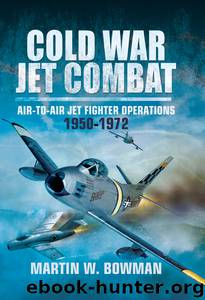Cold War Jet Combat by Bowman Martin;

Author:Bowman, Martin;
Language: eng
Format: epub
Tags: HISTORY / Military / Aviation
ISBN: 4447594
Publisher: Pen and Sword
Published: 2016-01-29T16:00:00+00:00
Scramble! Air and ground crew race to their waiting and fully armed F.2A at the start of another intercept sortie. (Richard Reeve)
A 11 Squadron Lightning F.6 on QRA. The Q Shed, a self-contained unit which housed aircrew and ground crew in an adjacent bungalow, was built away from the airfield hangars, next to the main runway, so the aircraft minimised taxiing time prior to take off. (Malcolm English)
RAF Illuminated plotting board in the early part of the Cold War.
Once an alert sounded the two pilots would belt for their transport and drive across to the pan, where, strapped in, they were ready to be airborne within two minutes. Ground crew supplied external power to the Lightnings during these waiting periods and the pilots got their briefing via a plug-in telebrief direct from the relevant operations room. Many of the Lightning alerts were practices - intruders simulated by Canberras from RAF Germany - but there were “quite a few” visitors from Russia, some of them long-range maritime flights from the far north, which flew past Norway and turned over the Shetlands. Visual identification of strange targets was practiced by the Lightning pilots making an approach to an intruder from behind and at 300 yards range identifying the intruder visually. At night this had to be done in whatever light was available. On all occasions a radar lock-on had to be achieved. The aircraft, which were put up against the QRA force, included Canberras, Phantoms, Buccaneers and Sea Vixens. All Lightning pilots had an intensive aircraft recognition course at OTU and when they arrived on the squadron they were kept in practice by continuous refresher training both simulated and live. Some visitors clearly tested the readiness of the QRA force with some intruders’ playing ‘cat and mouse’ with the Lightnings, flying close enough to wake up pilots and then turn away before they were scrambled. Others listened for the signatures of NATO ECM devices and there were the electronic-intelligence gatherers, which flew around listening to radio and radar frequencies. There were even some practice bombing runs. Whatever the intruders were doing the Lightnings intercepted, identified and accompanied them out of the area, armed with cameras and live missiles. Nobody has ever refused to go.
Normally the Lightnings on QRA operated with the local air-defence radar network, which would vector the interceptors on to a target until the Ferranti Airpass AI23B radar had picked it up. The AI23B was a pilot-interpreted system, which meant that the pilot must position himself within brackets, which were displayed in order to make an effective missile firing. To do this he could fly a computed flight path, also displayed, or position himself manually. The technique in an attack was to approach a target either very high or very low so that the intruder could easily be seen without the Lightning itself being spotted. For very high-level attacks the technique was to accelerate to supersonic speed near the tropopause and then climb at attack speed to the height required.
Download
This site does not store any files on its server. We only index and link to content provided by other sites. Please contact the content providers to delete copyright contents if any and email us, we'll remove relevant links or contents immediately.
| Anarchism | Communism & Socialism |
| Conservatism & Liberalism | Democracy |
| Fascism | Libertarianism |
| Nationalism | Radicalism |
| Utopian |
The Secret History by Donna Tartt(18162)
The Social Justice Warrior Handbook by Lisa De Pasquale(11954)
Thirteen Reasons Why by Jay Asher(8452)
This Is How You Lose Her by Junot Diaz(6440)
Weapons of Math Destruction by Cathy O'Neil(5831)
Zero to One by Peter Thiel(5490)
Beartown by Fredrik Backman(5357)
The Myth of the Strong Leader by Archie Brown(5239)
The Fire Next Time by James Baldwin(5017)
How Democracies Die by Steven Levitsky & Daniel Ziblatt(4958)
Promise Me, Dad by Joe Biden(4908)
Stone's Rules by Roger Stone(4857)
100 Deadly Skills by Clint Emerson(4691)
A Higher Loyalty: Truth, Lies, and Leadership by James Comey(4551)
Rise and Kill First by Ronen Bergman(4545)
Secrecy World by Jake Bernstein(4389)
The David Icke Guide to the Global Conspiracy (and how to end it) by David Icke(4380)
The Farm by Tom Rob Smith(4323)
The Doomsday Machine by Daniel Ellsberg(4246)
